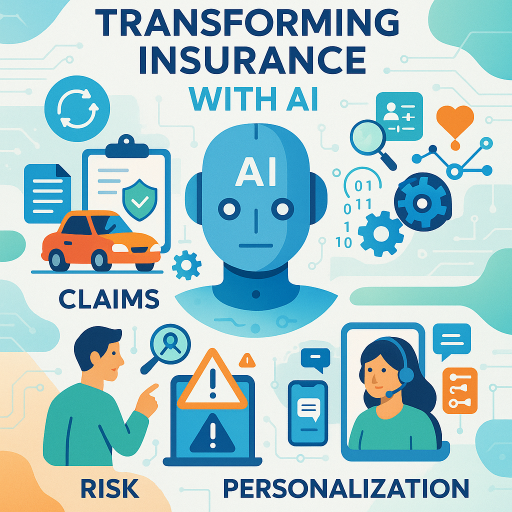In an industry often characterized by caution and tradition, a quiet revolution is underway. Insurance, the centuries-old practice of risk assessment and protection, is being transformed by artificial intelligence at a pace that surprises even industry veterans. A comprehensive systematic review has recently shed light on exactly how AI is reshaping insurance across automotive, health, and property domains, and the findings reveal both impressive advancements and concerning gaps.
Bridging Research and Reality in AI Insurance Applications
Researchers examining 65 academic papers and 33 industry sources discovered that AI’s integration into insurance operations goes far beyond simple automation. The study, following the rigorous PRISMA methodology, reveals that AI is fundamentally altering how risks are assessed, claims are processed, and customers are served across multiple insurance domains.
What’s particularly fascinating is the disconnect between academic research and real-world implementation. While academics have concentrated heavily on pricing and risk assessment (42% of research papers), industry applications show a more balanced approach across service categories. This gap highlights the need for closer collaboration between researchers and practitioners to ensure AI developments address actual market needs.
Five Ways AI is Transforming Insurance
1. More Sophisticated Pricing and Risk Assessment
Gone are the days when insurance pricing relied solely on historical data and broad demographic categories. Today’s AI systems analyze telematics data from vehicles, behavioral patterns from mobile devices, and environmental factors from various sources to create remarkably accurate risk profiles.
For instance, in automotive insurance, machine learning algorithms can process driving behavior data to identify risky patterns that traditional analysis might miss. A driver who frequently accelerates rapidly might receive a different premium than one who maintains steady speeds, even if both have similar driving records.
2. Streamlined Claims Processing and Damage Detection
Perhaps the most visible AI application for consumers comes in claims processing. Computer vision and deep learning models can now automatically assess vehicle damage from photographs, evaluate property destruction after natural disasters, and even identify potential medical insurance claim issues.
These technologies dramatically reduce processing times, from days or weeks to mere minutes in some cases, while simultaneously improving accuracy and reducing fraud. The customer experience improves significantly when valid claims are processed quickly and efficiently.
3. Personalized Customer Experiences
The one-size-fits-all insurance model is rapidly becoming obsolete. Machine learning algorithms now help insurers create highly customized products based on individual risk profiles and preferences. This shift toward hyper-personalization means consumers pay more precisely for their specific risks rather than subsidizing higher-risk individuals within their demographic group.
Health insurers, in particular, have embraced this approach, with 23 documented AI implementations, the highest among insurance domains. These range from personalized wellness programs to customized coverage options based on individual health data.
4. Enhanced Fraud Detection
Insurance fraud costs companies billions annually, expenses ultimately passed to consumers through higher premiums. AI’s pattern recognition capabilities have revolutionized fraud detection by identifying subtle inconsistencies and suspicious patterns that human investigators might miss.
Advanced natural language processing can analyze claim descriptions for linguistic markers that correlate with fraudulent claims, while network analysis can identify coordinated fraud rings by detecting previously hidden connections between seemingly unrelated claims.
5. AI-Powered Strategic Decision Making
Beyond operational improvements, AI is transforming how insurance executives make strategic decisions. Dynamic financial analysis powered by AI helps companies optimize capital allocation, while process simulations identify efficiency opportunities throughout organizations.
This strategic deployment of AI has become particularly important as traditional insurers face competition from insurtech startups unburdened by legacy systems and processes.
Critical Challenges for AI Implementation
Despite promising applications, the systematic review identified several significant hurdles insurers must overcome to fully realize AI’s benefits:
Data Quality and Governance
AI systems are only as good as the data they’re trained on. Many insurers struggle with fragmented data systems, incomplete historical records, and inconsistent data collection practices. Establishing robust data governance frameworks remains a prerequisite for effective AI deployment.
Ethical Considerations
Insurance, by its nature, involves categorizing risks, but AI systems can inadvertently perpetuate or amplify existing biases. Ensuring fairness, transparency, and accountability in algorithms requires ongoing vigilance and specialized expertise that many insurers are still developing.
Regulatory Compliance
Insurance is already one of the most heavily regulated industries, and AI introduces new compliance challenges. Systems must adhere to complex regulations like GDPR, HIPAA, and the emerging EU AI Act. The review notes that regulatory frameworks are still evolving, creating uncertainty that can slow innovation.
The Explainability Imperative
Unlike some industries where black-box AI solutions are acceptable, insurance decisions often require transparency. Customers, regulators, and insurance professionals themselves need to understand why an AI system reached a particular conclusion, especially for denied claims or premium increases.
Continuous Adaptation Requirements
Risk factors and market conditions constantly evolve, particularly in an era of climate change and rapid technological advancement. AI systems must be regularly updated to remain accurate, requiring ongoing investment and specialized expertise.
The Research-Industry Implementation Gap
One of the review’s most valuable contributions is highlighting where academic research fails to align with industry needs. Property insurance, for instance, shows significant industry innovation in policyholder behavior analysis and claims automation that isn’t matched by academic attention.
This misalignment means potential solutions to industry challenges may go undeveloped while researchers focus on already well-served areas. The authors suggest more collaborative research models where academics and industry practitioners jointly identify priority research areas.
Future Directions: Where AI in Insurance Is Headed
Looking forward, the authors identify several promising directions for AI in insurance:
- Environmental and ESG Integration: Future AI systems will increasingly incorporate environmental data and ESG metrics to enhance risk accuracy, particularly important for property insurance in an era of climate change.
- Explainable AI Frameworks: New approaches to AI that prioritize transparency and explainability will help ensure regulatory compliance while maintaining performance.
- Climate Risk Assessment: Specialized AI systems for evaluating climate-related risks will become essential for property insurers as weather patterns become less predictable.
- Governance Frameworks: New models for AI governance that align with both ESG considerations and regulatory requirements will emerge to guide responsible implementation.
The systematic review makes clear that AI in insurance isn’t merely about operational efficiency, it’s fundamentally transforming how risk is understood, priced, and managed. The insurance industry, despite its conservative reputation, is embracing AI at a remarkable pace, recognizing that the technology offers solutions to long-standing challenges.
For consumers, this evolution promises more personalized products, faster claims processing, and potentially fairer pricing. For insurers, AI offers competitive advantages through better risk assessment, reduced fraud, and enhanced strategic decision-making capabilities. The key will be navigating the implementation challenges while ensuring systems remain fair, transparent, and compliant with evolving regulations.
What do you think about AI’s role in insurance? Are you excited about the potential for more personalized policies and faster claims? Or concerned about privacy and fairness issues? Share your thoughts in the comments below.


